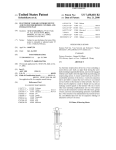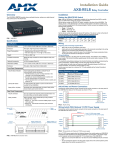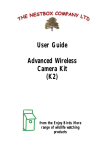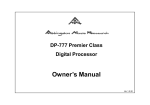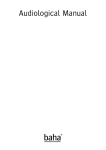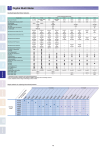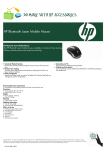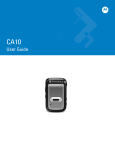Download Connecting with the community
Transcript
February 2008 Newsletter Community Connections The Cochlear Awareness Network Journey to Sound Making the most of your implant Connecting with the community Accessorise Now! Connecting you to the outside world 2007 Winner Graeme Clark Scholarship Baha Intenso™ Providing power and discretion The Cochlear Awareness Network (CAN) is a group like-minded volunteers who want to make a difference. Many thousands of people are missing out on getting a hearing implant. CAN volunteers raise the general awareness of hearing implants within their local community, letting others know the dramatic difference such implants can have on others with a significant hearing loss. All CAN members are either cochlear implant or bone conduction implant recipients and have volunteered to share their personal stories, insights and experiences at various speaking engagements and in personal meetings. Their role is that of an ambassador. They offer support, but not advice. They share their knowledge, but they are not medical professionals. The volunteers are not employees of Cochlear and participate in activities in their own time. Goals of the Cochlear Awareness Network • To raise community awareness of cochlear implants and bone conduction implants Sharing Experiences in ANZ The Cochlear Awareness Network for Australia and New Zealand was launched in September 2006 and now has 27 committed volunteers. “It’s all part of the hearing experience - helping people with shared experiences to connect,” said Mischelle Edmunds, Cochlear Awareness Network Coordinator. “Our CAN members have delivered close to 200 presentations to community groups and many have told their stories in print and broadcast media in the hope of bringing hearing to more people than ever before,” said Mischelle. • To ensure that candidates receive correct information about Cochlear products • To offer support to candidates on the next steps for receiving an implant • To inspire audiences with their personal stories • To bring hearing to more people than ever before The Cochlear Awareness Network is a worldwide programme, with volunteers throughout Asia Pacific, Europe and the US. If you are interested in becoming a member of the Cochlear Awareness Network, please contact: Australia & New Zealand – Mischelle Edmunds at [email protected] Southeast Asia – Leah Labrador at [email protected] China – Rachel Wang at [email protected] Japan – Harumi Iwakawa at [email protected] Connect CAN Volunteer Profile: Robyn Carter Hearing Loss Classification: Profound Duration of Hearing Loss: 44 years Age at onset of Hearing Loss: Birth Age at implantation: 31 years Country: New Zealand I was born with a mild hearing loss but didn’t get my first hearing aid until I was 10. Unfortunately in my 20’s, I lost all my hearing. At the age of 31, I received a cochlear implant, the eighth adult in New Zealand to receive one. What a world of difference this made for me. The implant gave me more hearing than I had when I was 10 years old. Within two years of having the implant, my salary had doubled from promotions that I had previously been passed over for! I wear my implant from the time I get up in the morning, until I go to bed at night. I hate being without sound as it makes me feel disconnected from the world. As well as CAN, there is also a wide range of user support groups in the Asia Pacific region, including the following three, working to establish connections in the community. Why did you volunteer for CAN? I was already helping out as much as I could when needed, for example, talking to prospective implantees. I also wasn’t working at that time so I thought this would be a great way of giving back what the implant has done for me. What do you enjoy about being a CAN volunteer? Being a member of CAN has enabled me to meet a wide range of people throughout New Zealand and Australia with similar experiences to mine. It has enabled me to educate the public on what it’s like being deaf, to empathise with those going through similar experiences, and to help them through their decision making process by answering their questions. It’s a great feeling to get feedback from people on how my experiences have touched them in some small way or to know that because of my presentation, someone has done something about their hearing difficulties, or has gone on to receive a cochlear implant. What activities are you involved in? I mainly give presentations to Grey Power, Rotary, or Probus groups around New Zealand. I also spend time with the Cochlear Implant Programme talking to people about their cochlear implants and answering their questions. The other main activity I do is write lots of letters to the government imploring them to increase funding for cochlear implants in New Zealand and to reduce the growing waiting lists. Why would you recommend CAN participation to other recipients? It’s extremely rewarding work. You get to meet many people from all walks of life, often making firm friendships. It gives you ever growing confidence in yourself, which is sometimes lacking because of your inability to hear. Cochlear gives you lots of support, encouragement and information and are great to work with. I think it’s the best thing I’ve ever done. 01. CICADA (Australia) 02. ACITA (Japan) 03. CIPS (India) CICADA is an Australian support organisation established in 1984 by cochlear implant recipients. Its headquarters and Club Room are located in the grounds of Old Gladesville Hospital in Sydney. The group is affiliated with various social groups and independent CICADA associations in other states and regions of Australia. CICADA aims to provide support through fellowship, educational and social interactions and produces national and state newsletters to keep everyone up-to-date. Members provide information for candidates and other recipients, sharing their personal experiences at presentations, lectures and classes. There are also regular social functions, such as BBQs & dinners, which allow members to socialise. ACITA (Association of Cochlear Implant Transmitted Audition) is the association of cochlear implant recipients in Japan and was launched in 1988. The group’s goals are to create opportunities for recipients to socialise and communicate with each other and to improve their quality of life, in collaboration with medical professionals and manufacturers. ACITA is pronounced the same as the word for “tomorrow” in Japanese and the founding members chose this to symbolise a brighter future for recipients. The group currently has around 1,250 members. Of these, there are about 1,050 recipients and their family members, with the remaining 200 consisting of unimplanted hearing-impaired persons, medical and educational professionals and manufacturers. ACITA produces a quarterly newsletter in February, May, August and November every year, providing members with the latest information on cochlear implants and a forum for communication. CIPS is the Cochlear Implant Parents Society of India. Cochlear implants were a unique and groundbreaking technology in India with very few recipients in the beginning, therefore the families of the recipients lacked a reference point to share their unique experiences and problems. Five CI families came up with the idea of forming a group of families with cochlear implants, to support each other in a community where there were few others with whom they could identify. Their vision was clear, but there were many obstacles to setting up the group. However, they did not give up, and were always ready to tackle any challenges to fulfil their dream. In those early days, CIPS only had support from the parents, Cochlear and Pika Medical, and strong bonds were made during this difficult time. Finally in 2006 the dream became reality with the registration of CIPS. The group feels that while doctors and audiologists can tell you the procedures involved and what results may be achieved, they cannot add the dimension of personal experience. Furthermore, CICADA members have experienced severe or total hearing loss and its impact on families and friends – an issue not readily understood by the general community. In order to further its work, the group has links with organisations for the deaf and hearing impaired and has an interest in helping to lobby governments and health funds regarding policies. An annual meeting is organised, with members getting together from all over the country. The meeting is open and friendly and provides several programs to understand more about cochlear implants with special lectures by medical professionals and presentations from manufacturers. Members also enjoy the social activities and group tours that are arranged. ACITA will celebrate its 20th anniversary this year and the commemorative annual meeting will be held in Tokyo in June. Looking ahead to the future of ACITA, the steering committee has already started preparations to make this fruitful event a major milestone in ACITA’s history. Today CIPS has more then 300 families in the group and its objectives have also evolved. Activities now encompass a wide range of initiatives, such as the rehabilitation of CI recipients, organising workshops to create awareness of hearing impairment and CI, assisting hearing impaired people in making a well-informed decision about getting a cochlear implant and integration of recipients into mainstream schools. The group is also involved with liaising with the government and its agencies on policies to improve the welfare of recipients and co-ordinates its activities with other organisations working for the hearing impaired. CIPS looks forward to a better and healthy tomorrow for hearing impaired children and welcomes more families to work together towards a brighter future for the hearing impaired. Making the most of your implant & beyond… Choosing to have a hearing implant is an important decision for any family, whether it be parents deciding for their child or adults making the choice for themselves. However, as most will agree, having surgery is only the beginning of the journey to sound. Many recipients continue to develop new skills and discover new sounds around them many years after their surgery and initial switch-on. Auditory habilitation (for children) and rehabilitation (for adults) can be an extremely useful and invaluable tool. Many people find (re)habilitation helps them to get the most out of their cochlear implant system or bone conduction system. There are many different schools of thought when it comes to (re)habilitation and there is a range of styles to choose from. Different approaches appeal to different people, but fundamental to the various methods is the need to concentrate on developing listening and speech skills. Cochlear produces a range of materials for professionals or for you to use yourself with support from your hearing professional. Sound and Beyond™ – Sound and Beyond is a self-paced, interactive software application designed to help adult cochlear implant recipients practice and develop their listening skills. It is formatted so adult recipients can work alone and teen recipients can work either alone or with a parent. Adult Aural Rehabilitation – This comprehensive package is a multipurpose resource developed for professionals working with adults and older teenagers with a hearing impairment. It serves as both a resource of rehabilitation materials and as a training guide for new staff. The package consists of a guide, booklet, DVD and CD-ROM. Listen Learn and Talk – Focusing on the natural bond that exists between parents and their children, this auditory habilitation program is designed for children with a hearing impairment identified under 12 months. This program helps parents guide a child through their journey into a world of sound, listening and language development. Consisting of a book and DVD, this is developed for both parents and professionals to complement a child’s habilitation program. Nucleus® hear we go! – This easy to use software program for professionals can be used to generate individual rehabilitation material that is interesting for teenagers. Topics include cars, bikes, fashion and space travel to name just a few. Parents and professionals will also benefit from topics covering telephone training and communication strategies. Di-EL First Words™ (Diary of Early Language) – is a valuable tool for early language development of young children. Based on the language development of children with a hearing impairment, Di-EL First Words allows professionals to access information on language development to objectively assess a child’s progress acquiring early language. The CD includes a database, video clips and printable resources to capture the first 100 words and any word combinations used while reaching this target. This flexible program can be used as a written diary, through email or regular phone call correspondence. Accessories from Cochlear are all about connecting you to the outside world. This could mean listening to a teacher in a classroom, dancing along to the latest pop tune or enjoying a new blockbuster movie at your local cinema. Some recipients prefer to use their system on its own, but many find accessories are a great way to help them connect with the world around them. Why not take some of your accessories out of that dusty drawer today and hear the difference! 06 03 Accessorise this season! Cochlear Implant Accessories Bone Conduction Implant Accessories 01 Personal audio cable Helps you keep up with all the exciting personal audio products on today’s market. Use the personal audio cable for simple connection to an iPod®, Walkman®, MP3 player, portable radio or other battery-operated audio products. You can change the volume in the usual way and use the sensitivity control to increase and decrease the amount of environmental sound you get. Don’t forget to leave on enough environmental sound when you’re out and about, e.g. driving or walking along the road. Also remember you must use only your TV/Hi-Fi Cable when you connect to mains-powered audio equipment. Listen safely! 06 Audio adapter This allows direct input from personal stereos, TVs, MP3 and Hi-Fi equipment 02 TV/Hi-Fi Cable Connects to mains-powered audio equipment like televisions, home stereos, personal computers, and gaming consoles such as the Xbox® or Sony Playstation®. You can change the volume in the usual way and use the sensitivity control to increase and decrease the amount of environmental sound you get. 07 Telecoil This improves sound quality and speech understanding with personal loop systems in the home and in buildings with a loop facility 08 MicroLink Baha FM-receiver This receiver from Phonak enables link up with most FM transmitters *Accessory usage can differ between different sound processors and can depend on how your programs are set up. Please refer to your user manual for more information if required. 03 Lapel Microphone Provides an external microphone separate to your system’s usual built-in microphone. Connecting this, you will only hear sounds through the lapel microphone and you can adjust sensitivity and volume in the usual way. Can be useful in especially noisy and challenging listening environments; simply place the microphone close to the person or sound you want to hear. 04 Telecoils Delivers greater clarity for listening on the phone. Improves sound quality in buildings with a loop facility, e.g. cinema. 05 Telephone Adapter Improves signal strength and sound quality. Get a telephone adapter for the better sound quality when talking on the phone. The telephone adapter bypasses your implant’s microphone and sends a strong sound signal directly to your processor. 08 01 02 07 An auditory brainstem implant* (ABI) is especially designed to restore a sense of hearing by direct stimulation of the cochlear nucleus area of the brainstem. It is of particular benefit to patients with a disease called Neurofibromatosis Type 2 (NF2). Winner announced: Graeme Clark Scholarship 2007 In NF2 patients, hearing is often destroyed by the presence of acoustic neuromas (tumours) or by surgery to remove them, which can require cutting the acoustic nerves. For those NF2 patients with bilateral dysfunctional auditory nerves, a normal cochlear implant is not an option as there is no neural connection between the cochlea and the brain. However, the Nucleus® 24 ABI can restore a sense of hearing for these patients and can help them better cope with their chronic illness. The Nucleus 24 ABI is also potentially beneficial for other situations where there is bilateral dysfunction of the auditory nerve, such as cases of skull trauma. When did the ABI Program at St Vincent’s commence? The first ABI was done in December 1995. There were no other programs in NSW and the only other program was in Victoria, which started at about the same time. The Department of Otolaryngology, Head and Neck Surgery at St Vincent’s Hospital in Sydney is known as one of the leading ENT departments in Australia and has gained national and international recognition as a centre of excellence for its clinical practice and teaching programs. Its areas of expertise include: skull base surgery, head and neck cancer surgery, advanced otologic surgery, cochlear implant and bone conduction implant surgery, to name just a few. The department is one of a select few around the world that carries out ABI surgery. Can you tell us more about this group of patients? The ages of those who have been implanted goes across the whole age spectrum from late teen years up to 70’s, with the majority of the patients being under 40. The youngest patient was probably our first patient who was a teenager. How well a patient does with an ABI is dependent on their motivation to wear the device, as the device acts as an aid to lip-reading. Together with Professor Paul Fagan and Dr. Phillip Chang, Dr. Nigel Biggs is one of the surgeons who specialises in auditory brainstem implants. Here he talks to us about the successes and challenges of St Vincent’s ABI Program. How many recipients are there on the program? There are only 12 patients who have been implanted with this device. Patients are implanted with an ABI as a result of losing their hearing in both ears from acoustic neuromas, accidents or other pathologies that damage the acoustic nerve so that they are not able to have a cochlear implant. This requires a device that is implanted above where the lesion was situated. So far we have only implanted patients who have Neurofibromatosis Type 2 (NF2) and have developed bilateral tumours, however patients with other pathologies have been implanted in other centres. What are patient outcomes like with an ABI? Patient outcomes are related both to how much information their implant gives them and their motivation to wear it. The position of the electrode pad on the brainstem is very important with the ABI. It does not have its position dictated by placing it in a defined organ and so it is much more difficult to get it in the best position. During surgery, intraoperative monitoring helps find the best placement, allowing the surgeon to find a position that will not cause other nerves to be stimulated (e.g. facial nerve) and will give the best auditory signal. Results in other centres have found that patients who are implanted for reasons other than NF2 have done much better achieving speech perception scores much more like a cochlear implant. The reasons for this could be that either the tumour or the surgery to remove the tumour damages the cochlear nucleus, resulting in poorer scores for the NF2 patients. What are some of the challenges of working with ABI? Programming an ABI is much more demanding than a cochlear implant because you have to find the best combination of electrodes possible for the best result (electrodes are not pitched ranked as in a cochlear electrode). Also the magnet is not used with these patients, instead they use a doublesided sticky disk and often it can take a while to find the best position of the coil before you even get started. It is also very common for these patients to have other non-auditory sensations when they are being mapped which may be something like a dizzy feeling, a nauseous sensation or even a nerve twitch in their leg. These sensations can generally be programmed out. NF2 patients have lots of other challenges that have to be considered when trying to program them. What are some of the rewarding aspects of working with ABI. A rewarding side to this work is that you are able to make people’s lives a little easier than they otherwise would be without your input. It means instead of being totally cut off from the world they are able to hear environmental sounds and have some help with lip reading. * Please note that the Nucleus® 24 ABI is not available in all markets. Please contact your local Cochlear office for additional information. Auditory Brainstem Implant Dr Nigel Biggs Specialist surgeon in auditory brainstem implants St Vincent’s Hospital Sydney, Australia The Graeme Clark Scholarship, established in 2002 in Australia and New Zealand, encourages Cochlear’s recipients to undertake tertiary studies. Twenty year old RMIT University student, Kate Moss is the 2007 award winner. Kate was diagnosed with a bilateral sensorineural profound hearing loss at the age of 12 months and turned to Cochlear, becoming a recipient in June 1998 when her hearing aids were no longer enough. Extremely happy with her cochlear implant, Kate became a bilateral recipient receiving her second implant in December 2006, which helped to improve her speech perception, listening and communication skills, and provided a greater spectrum of sounds. Cochlear implants have been successful additions to Kate’s life, as she says, “I now feel that I can hear so much more with two implants than with one and wouldn’t change anything.” Kate was happy to share her experiences with us and what she thinks the future holds for her. What attracted you to the Graeme Clark Scholarship? It was only due to the efforts of my audiologists Liz Winton and Rod Hollow from the Cochlear Implant Clinic, who strongly encouraged me to apply for the scholarship. There were several reasons why I was attracted to the Graeme Clark Scholarship. Firstly, the financial assistance towards university studies was a huge incentive. Secondly, winning a highly prestigious scholarship was always going to look good on my CV and will assist me enormously in my future endeavours, wherever I may go. How do you think this Scholarship will help you in your future? On a personal level, winning the scholarship has helped me in the sense that the judges have recognised my hard work, determination and effort to get to where I am today. The scholarship has also given me the confidence in believing that I can achieve anything that I set out to do. I know without a doubt that I wouldn’t be where I am today if I didn’t have the two cochlear implants and the support from my family, friends and teachers. Financially, the scholarship will also help me with the costs associated with university studies. I am so beyond grateful that I was the successful applicant of the 2007 Graeme Clark Scholarship. How has becoming a cochlear implant recipient benefited you? Having the cochlear implants has changed my life in many ways, not only have my verbal and listening skills improved dramatically, but I am now able to do a variety of activities previously thought impossible. Throughout my school life, I participated in an array of activities, there was nothing that I didn’t do or couldn’t participate in. After I received the first implant, the list of activities that I participated in was endless! I played the clarinet and the piano, did jazz and debating, was in the school play, was involved with the swimming squad and played a variety of sports such as hockey, netball, cricket and racquetball. I also won numerous academic awards each year and was awarded a prestigious scholarship in my final year for ‘overall endeavour to pursue excellence in all areas of school life’. Furthermore, I was truly fortunate to receive three university offers; something that I never thought would be possible. I truly believe that none of my activities and achievements would have been possible if it weren’t for the cochlear implants. Has it also helped your relationship with friends and family? Cochlear implants have allowed me to communicate and interact more in social environments, especially with family and friends. If I didn’t have the cochlear implants, I doubt that I would have the confidence to interact with people I don’t know. This is why the implants are such a great blessing. What suggestions do you have for others that are considering a cochlear implant? Go for it! While I had nothing to lose with the first implant, I must admit that I had some feelings of doubt and reluctance, which was only natural. I was most concerned with the notion that the implant would not be a success. I do understand that choosing to have a cochlear implant is a big decision. My life has changed for the better rather than for the worse since choosing to have the implants. When it comes to choosing whether to have a cochlear implant, the sky really is the limit! In life there are always challenges to meet. With a hearing impairment, it can be a tad more difficult. While it hasn’t been easy, I believed in the fact that if I made the most of what I was given and utilised it in an appropriate way, I could go a long way. Everybody, particularly my parents, my three sisters and my grandparents helped me to believe that I could do anything within reason. They encouraged me to be self-motivated, enthusiastic and to involve myself fully in life. Having a hearing impairment has certainly made a difference to my life but I feel that I have been able to meet that challenge with the support of so many people. Do you know what the greatest compliment that I can ever receive is? The greatest compliment I can ever get is being told by someone that they had no idea I was deaf when I communicated with them. Whenever I hear that compliment, I always silently thank Taralye, an early intervention centre I attended as a young child and Professor Clark. They are both part of the reason, as well as years of intensive speech therapy, why I am where I am today. I am forever grateful to Professor Clark and how his invention, the cochlear implant, changed my life so radically. When it comes to the cochlear implant, I would strongly encourage those considering this decision to go for it. The results are truly amazing and life-changing. 2007 winner of the Graeme Clark Scholarship Award Kate Moss Now Available Hear the Power with Baha Intenso™ Using powerful hearing devices can be an exercise in the art of compromise: should you favour discretion at the cost of power or sacrifice discretion for better hearing? With the new Baha Intenso™, Baha recipients don’t have to make that choice. This innovative small, digital, head-worn device has been specifically developed to provide the power you’ve been looking for, as well as the discretion you desire. “My Intenso is much better than my previous devices in all environments because it makes the sound clearer and more distinct, ” says Marianne, who travelled around Asia and enjoyed the higher power of the Baha Intenso. Intenso doesn’t just provide more power. With advanced digital signal processing supported by Active Feedback Cancellation, it is designed to deliver clearer sound quality in all types of listening environments plus far less irritation from feedback. Call for Applications: Graeme Clark Scholarship 2008 Australian and New Zealand students with a Cochlear implant system are invited to apply for the 2008 Graeme Clark Scholarship. The scholarship is open to recipients who reside and undertake study in an accredited university in Australia or New Zealand. For more details and the application form, please visit: www.cochlear.com.au/community/600.asp. Entries close 30 June 2008. Write in and tell us your story Share your journey to a world of sound with others! Write in and tell us your story. Adapts to your personal needs With its digital signal processing, Intenso provides a tailor-made response to your hearing loss and your environment. It automatically reacts to protect you from sudden, unexpected noises. This improves sound quality in loud environments without the need for manual adjustments. Integral to this concept is the flexibility of three listening programs. • Program 1 – for everyday listening. This helps you to hear best in most situations – whether you’re communicating with colleagues or communing with nature. • Program 2 – for comfort in noisier environments such as busy train stations or shopping centres. It reduces the impact of unwanted low-frequency noise for maximum comfort and protection. • Program 3 – for a relaxing break, this lets you listen exclusively to external audio sources such as MP3 music players, as well as FM systems. If you need a quick break from the world of sound, this program will also mute the sound processor. Digital Intelligence Feedback can be a constant source of frustration and irritation. In addition to limiting your physical movements, the threat of annoying whistling can even force you to turn the volume down, temporarily limiting your ability to hear clearly. Baha Intenso addresses these issues with Active Feedback Cancellation (AFC). This sophisticated system constantly monitors the sound signal and if feedback does seem likely to occur, swift steps will be taken to counter it. “The sound with Intenso is stronger than my previous device so it’s easier for me to hear and I don’t get the same problems with whistling,” says Kåre, a recent Intenso convert. Baha sound processors Baha Intenso complements the existing range of Baha sound processors. Baha Divino provides a state-of-the-art head-worn solution for recipients who need a moderate amount of gain/ amplification. Baha Intenso is a more powerful head-worn solution for those who need stronger amplification. Last but not least, for those that require the highest level of amplification, there is the bodyworn Baha Cordelle II, which is the most powerful sound processor of the three. With the addition of the Baha Intenso to the range, the Baha Compact and Baha Classic have both been phased out and are now no longer available. Divino® Premium performance All-round device Intenso™ Headworn power Discreet device Cordelle II Super power device -Excellent sound quality through digital platform - Directional microphone for better speech in noise understanding - Smaller housing - Up to 45dBHL sensorineural component -Excellent sound quality through digital platform - High power for better audibility - Active feedback cancellation and comfort program - Up to 55dBHL sensorineural component -Bodyworn unit for maximum power - Inbuilt telecoil, tone controls, electrical input - Up to 65dBHL sensorineural component Accessorising the Intenso To further enhance your sound experience with Baha Intenso in different environments, a range of specially designed, easy-to-use accessories are available. For further information on Cochlear and its products and services visit www.cochlear.com or contact your local Cochlear office or distributor. • Audio adapter – this allows direct input from personal stereos, TVs, MP3 and Hi-Fi equipment. • Telecoil unit – this improves sound quality and speech understanding with personal loop systems in the home and in buildings with a loop facility. • MicroLink Baha FM-receiver – this receiver from Phonak enables link up with most FM transmitters. * Not yet available in all countries. Please contact your local clinic for more information Hear Always Electronic Version In the interest of saving our trees, why not subscribe to this newsletter in an electronic format? Please go to www.cochlear.com/newsletter where you can provide us with your email address. www.cochlear.com Cochlear, the elliptical logo, Baha Intenso, Baha Divino, and Sound and Beyond are trademarks of Cochlear Limited. Baha and Nucleus are registered trademarks of Cochlear Limited. Di-EL First Words is a trademark of Hear Works Pty Ltd. iPod is a registered trademark of Apple Inc. Walkman and Playstation are registered trademarks of Sony Corporation. Xbox is a registered trademark of Microsoft Corporation. © Cochlear Ltd January 2008 N31871F ISS5 Want to read it again? Been trying to find a Hear Always article that you would like to read again? Or maybe you missed out on an issue? Back issues of Hear Always are available at http://www.cochlear.com.au/Community/940.asp








